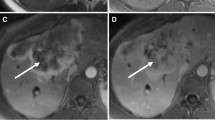Abstract
The purpose of this study was to report the magnetic resonance imaging (MRI) features of multiple biliary hamartoma (MBH) and to correlate them with histopathology. MRI features of 11 patients with MBH proven by histology were retrospectively reviewed and correlated to histopathology. MBH presented as multiple, tiny, and uniformly distributed lesions in all cases. All were hypointense on T1-weighted images and hyperintense on T2-weighted images relative to the liver parenchyma. Mural nodules were identified in 10 of 11 (91%) cases. They were isosignal on T1-weighted images, intermediate signal on T2-weighted images. Gadolinium-enhanced images showed mural nodule enhancement in 9 of 10 patients (90%) or a peripheral rim-like enhancement of the whole lesion in one case (9%). MBH were present in all liver specimens. In the six patients examined at MR cholangiography, the lesions lacked communication with the biliary tree. At histopathology, the mural nodule corresponded to an endocystic polypoid projection made of conjunctive septa. Three (27%) patients had associated focal nodular hyperplasia, and 1 (9%) had concomitant cholangiocarcinoma. MRI features allowed diagnosis of MBH with accuracy. Their recognition, especially the mural nodule, may help avoid misdiagnosis.



Similar content being viewed by others
References
Principe A, Lugaresi ML, Lords RC (1997) Bile duct hamartomas: diagnostic problems and treatment. Hepato-Gastroenterology 44:994–997
Cheung Y-C, Tan C-F, Wan Y-L, Lui K-W, Tsai C-C (1997) MRI of multiple biliary hamartomas. Br J Radiol 70:527–529
Slone HW, Bennett WF, Bova JG (1993) MR findings of multiple biliary hamartomas. AJR 161:1581–1583
Redston MS, Wanless IR (1996) The hepatic von Meyenburg complex with hepatic and renal cysts. Mod Pathol 9:233–237
Thommesen N (1978) Biliary hamartomas (von Meyenburg complexes) in liver needle biopsies. Acta Path Microbiol Scand 86:93–99
Tsui W (1998) How many types of biliary hamartomas and adenomas are there? Advances in anatomic pathology. Lippincott-Raven
Mortelé K, Ros P (2001) Cystic focal liver lesions in the adult: differential CT and MR imaging features. Radiographics 21:895–910
Iha H, Nakashima Y, Fukukura Y et al (1996) Biliary hamartomas simulating multiple hepatic metastases on imaging findings. Kurume Med J 43:231–235
Terada T, Nakanuma Y (1988) Congenital biliary dilatation in autosomal dominant adult polycystic disease of the liver and kidneys. Arch Pathol Lab Med 112:1113–1116
Semelka RC, Hussain SM, Marcos HB, Woosley JT (1999) Biliary hamartomas: solitary and multiple lesions shown on current MR techniques including gadolinium enhancement. J Magn Reson Imaging 10:196–201
Mortelé B, Mortelé K, Seynaeve P, Vandevelde D et al (2002) Hepatic bile duct hamartomas (von Meyenburg complexes): MR and MR cholangiography findings. J Comput Assist Tomogr 26:438–443
Maher MM, Dervan P, Keogh B, Murray JG (1999) Bile duct hamartomas (von Meyenburg complexes): value of MR imaging in diagnosis. Abdom Imaging 24:171–173
Gallego JC, Suarez I, Soler R (1995) Multiple bile duct hamartomas: US, CT and MR findings. Acta Radiol 36:273–275
Luo T-Y, Itai Y, Eguchi N et al (1998) Von Meyenburg complexes of the liver: imaging findings. J Comput Assist Tomogr 22:372–378
Alvarez Posadilla M, Linares Torres P, Jorquera Plaza F et al (2006) Importance of magnetic resonance imaging in the diagnosis of multiple small biliary hamartomas. Gastroenterol Hepatol 29:378–379
Martinoli C, Cittadini G Jr, Rollandi GA, Conzi R (1992) Case report: imaging of bile duct hamartomas clinical. Radiology 45:203–205
Wei S-C, Huang G-T, Chen C-H et al (1997) Bile duct hamartomas: a report of two cases. J Clin Gastroenterol 25:608–611
Zheng RO, Zhang B, Kudo M et al (2005) Imaging findings of biliary hamartomas. Word J Gastroenterol 11:6354–6359
Neri S, Mauceri B, Cilio D et al (2004) Biliary hamartomas (von Meyenburg complex): magnetic resonance imaging in a case report. Intern Med J 34:71–72
Chung EB (1970) Multiple bile duct hamartomas. Cancer 9:287–296
Levy A, Rohrmann C, Murakata L, Lonergan G (2002) Caroli’s disease: radiologic spectrum with pathologic correlation. AJR 179:1053–1057
Brancatelli G, Federle MP, Vilgrain V et al (2005) Fibropolycystic liver disease: CT and MR imaging findings. Radiographics 25:659–670
Mergo P, Ros P (1998) Hepatic imaging: benign lesions of the liver. Radiol Clin North Am 136:319–331
Honda N, Cobb C, Lechaco J (1986) Bile duct carcinoma associated with multiple von Meyenburg complexes in the liver. Pathol 17:1287–1290
Dekker A, Ten Kate FJW, Terpstra OT (1989) Cholangiocarcinoma associated with multiple bile-duct hamartomas of the liver. Dig Dis Sci 34:952–958
Hasebe T, Sakamoto M, Mukai K et al (1995) Cholangiocarcinoma arising in bile duct adenoma with focal area of bile duct hamartoma. Virchows Archiv 426:209–213
Burns CD, Kuhns JG, Wieman J (1990) Cholangiocarcinoma in association with multiple biliary microhamartomas. Arch Pathol Lab Med 114:1287–1289
Jain D, Sarode V, Abdul-Karim F et al (2000) Evidence of the neoplastic transformation of Von-Meyenburg complexes. Am J Surg Path 24:1131–1139
Kagawa Y, Kashihara S, Kuramoto S, Maetani S (1978) Carcinoma arising in a congenital dilated biliary tract: report of a case and review of the literature. Gastroenterology 74:1286–1294
Homer LW, White HJ, Read RC (1968) Neoplastic transformation of v. Meyenburg complexes of the liver. J Path Bact 96:499–502
Desmet VJ (2005) Cystic diseases of the liver. From embryology to malformations. Gastroenterol Clin Biol 29:858–860
Lev-Toaff AS, Bach AM, Wechsler RJ et al (1995) The radiologic and pathologic spectrum of biliary hamartomas. AJR 165:309–313
Author information
Authors and Affiliations
Corresponding author
Rights and permissions
About this article
Cite this article
Tohmé-Noun, C., Cazals, D., Noun, R. et al. Multiple biliary hamartomas: magnetic resonance features with histopathologic correlation. Eur Radiol 18, 493–499 (2008). https://doi.org/10.1007/s00330-007-0790-z
Received:
Revised:
Accepted:
Published:
Issue Date:
DOI: https://doi.org/10.1007/s00330-007-0790-z




